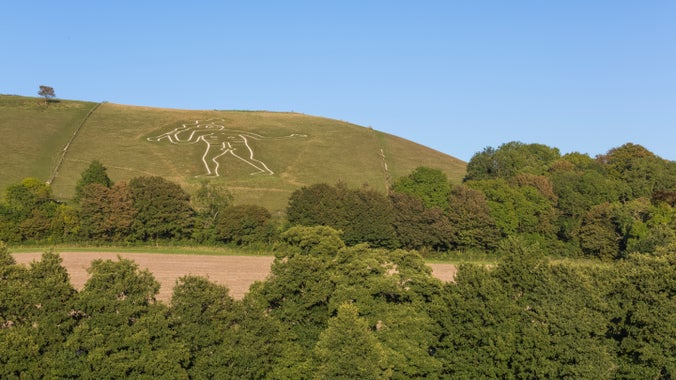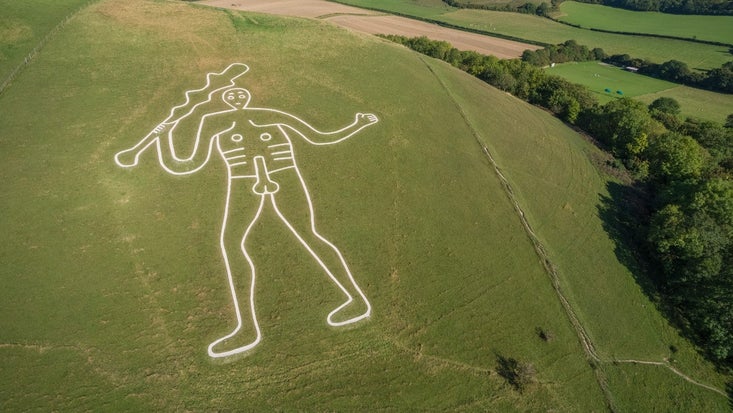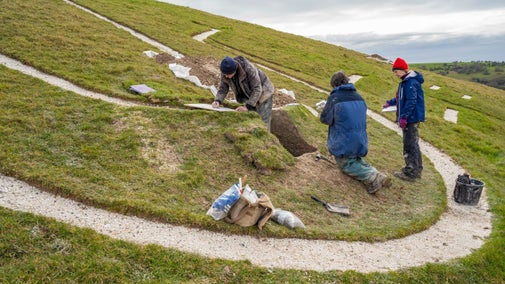
Become a member
Join today and help protect nature, beauty and history – for everyone, for ever. Enjoy access to more than 500 places with National Trust membership.
Ancient naked figure sculpted into the chalk hillside above Cerne Abbas
Cerne Abbas, Dorset, DT2 7AL

| Asset | Opening time |
|---|---|
| Countryside | Dawn - Dusk |
Please note, while free parking is available in the A352 lay-by (not managed by the National Trust), this area provides a limited view of the Cerne Giant. For a more optimal viewing experience, the nearby hills offer a better vantage point. The A352 lay-by is also suitable for coach parking, but it may not provide the best perspective.
Dogs are welcome, but please keep them on leads
The car park is on flat, level tarmac and has one designated accessible parking space. A viewing area is located in the car park and offers the best view of the giant. The giant itself is on a very steep slope along a mixture of grass and chalk surfaces. It can get very muddy after wet weather. Dogs should be on leads.
The car park is on flat, level tarmac and has one designated accessible parking space.
The giant itself is on a very steep slope along a mixture of grass and chalk surfaces. It can get very muddy after wet weather. To avoid damage and erosion, access to the giant is restricted
We've looked after the Cerne Abbas Giant and the small plot of land he calls home since 1920. Now we're committed to buying and caring for the land surrounding the Giant and with your support, we can transform it into a super site for nature. Please donate to the appeal so together, we can help restore the land, habitats and species that live there.

An ancient naked figure sculpted into the hillside. At 180ft, it's Britain’s largest, and possibly best-known, chalk hill figure.
Many rare chalk downland plants and invertebrates thrive in this chalk grassland which is of national and European importance.
Visitors often come to Cerne Abbas hoping to catch a clear view of the Giant on the hillside, but at times, he can look faint or be hard to spot. That isn’t an oversight and he hasn’t been forgotten. What you’re seeing is part of the care he receives.

Taking 12 months and using state-of-the art sediment analysis, the National Trust can for the first time reveal the likely age of the Cerne Giant, Britain’s largest and perhaps best-known chalk hill figure.

Sorry, there are no upcoming events at this place
The Cerne Giant is an ancient naked figure sculpted into the chalk hillside above Cerne Abbas in Dorset. Standing at 180ft tall the Cerne Giant is Britain’s largest chalk hill figure and perhaps the best known.
Many theories have surrounded the giant’s identity and origins, including ancient symbol of spirituality, likeness of the Greco-Roman hero Hercules, mockery of Oliver Cromwell and fertility aid. In 2021, after extensive scientific analysis, National Trust archaeologists concluded the giant was probably first constructed in the late Saxon period.
Above the giant is a rectangular earthwork enclosure, known as the Trendle, which is believed to date back to the Iron Age. It is still used today by local Morris Dancers as a site for May Day celebrations. The chalk grassland where the giant lies is of national and European importance for the many rare chalk downland plants and invertebrates that thrive here. Try and spot a marsh fritillary butterfly in May, and look out for wildflowers in summer.
The giant was given to the National Trust in 1920. Part of conserving the giant means leaving it alone as much as possible – the chalk is replaced every decade or so, a process that takes days of work by National Trust rangers and volunteers. The more the ground is disturbed, the quicker the giant erodes away.
We've looked after the Cerne Abbas Giant and the small plot of land he calls home since 1920. Now, we're committed to buying and caring for the land surrounding the Giant. With your support, we can transform it into a super site for nature. Please donate to the appeal so together, we can help restore the land, habitats and species that live there.


Join today and help protect nature, beauty and history – for everyone, for ever. Enjoy access to more than 500 places with National Trust membership.
By sharing your email address you’re agreeing to receive marketing emails from the National Trust and confirm you’re 18 years old or over. Please see our for more information on how we look after your personal data.